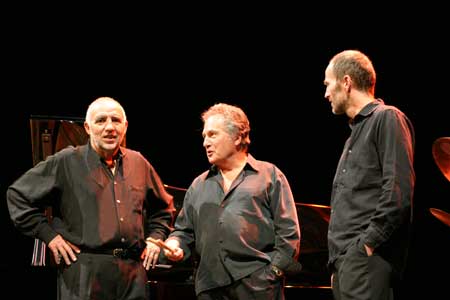| B i o g r a p h y |
 Jacques Loussier
was born in Angers, in northwestern France, October 26, 1934. He
started playing piano at the age of ten and quickly demonstrated
tremendous ability. When Loussier was just sixteen, he entered the
Conservatoire Nationale de Musique in Paris where he studied with
Professor Yves Nat whose youthful compositions were praised by Faure
and Saint-Saëns, and whose prodigious gifts as a pianist were
encouraged by Debussy. Continuing this distinguished lineage, Loussier
was to become one of Nat’s most accomplished pupils, heading the
conservatory’s piano class of over five hundred students before
leaving to commence a freelance career that included travels to South
America and the Middle East as well as work as accompanist for
Catherine Sauvage and Charles Aznavour.
Jacques Loussier
was born in Angers, in northwestern France, October 26, 1934. He
started playing piano at the age of ten and quickly demonstrated
tremendous ability. When Loussier was just sixteen, he entered the
Conservatoire Nationale de Musique in Paris where he studied with
Professor Yves Nat whose youthful compositions were praised by Faure
and Saint-Saëns, and whose prodigious gifts as a pianist were
encouraged by Debussy. Continuing this distinguished lineage, Loussier
was to become one of Nat’s most accomplished pupils, heading the
conservatory’s piano class of over five hundred students before
leaving to commence a freelance career that included travels to South
America and the Middle East as well as work as accompanist for
Catherine Sauvage and Charles Aznavour.
In 1959, Loussier hit upon the idea that was to make his international reputation, combining his interest in jazz with his love of J.S. Bach. Only a pianist with such an exceptional classical technique and deft improvisatory skill could have nurtured such a vision. He founded the Play Bach Trio, which used Bach’s compositions as the basis for jazz improvisation. The trio immediately caught the public imagination. In their live appearances, tours and concerts, plus a succession of recordings built on the cornerstone of four albums made for Decca between 1960 and 1963, Loussier’s group achieved a breakthrough to popular commercial success enjoyed by only a select few jazz musicians. In fifteen years, the trio sold over six million albums.
During its heyday, the trio broadened the range of its experiments with Loussier double tracking some pieces on organ and piano and, later, recording some of his arrangements of Bach’s concerti with the Royal Philharmonic Orchestra. However, after years on the road, like many popular commercial groups, the original trio reached the end of its natural life in 1978. In 1980, Loussier retired to his home in Provence to compose, research and record. He had already dabbled in film and ballet composition, and had established his own recording studio at Miraval, not far from Nice, where in addition to composing his own pieces for acoustic and electronic instruments, he played host to many recording stars of the rock world including Pink Floyd, Elton John, Sting and Yes. In fact, segments of Pink Floyd’s The Wall were recorded at Loussier’s studio.
Loussier’s own music in the 1980s explored the integration of new technology with conventional instruments, just as his 1950s experiments explored the ground between jazz and classics. He produced suites for piano, synthesizers, percussion and bass, and some rock-jazz-classical fusion works including Pulsions, Pagan Moon and Fusions Sous La Mer.
The tercentenary of Bach’s birth in 1985 coaxed Loussier back
to the trio format, and he re-formed the Play Bach Trio with two new
partners. He feels his new trio has far more stylistic range than its
predecessor, and whereas that was a pioneer group, the latter-day trio
combines jazz, rock and contemporary classical ideas with a mix of jazz
and Bach.
The trio keeps up a busy touring schedule, traveling annually in
Japan and the U.K. as well as in Loussier’s native France. It
also appears regularly in Germany, Spain and Italy. Loussier leaves
plenty of room in his schedule to write his own compositions. In 1986,
he produced a mass entitled Lumières, his first full-scale work
for symphony orchestra, which continues his exploration of the
synthesis of musical genres. In its Paris premiere, classical
countertenor James Bowman and soprano Deborah Rees found themselves
singing alongside a rock drummer. Loussier has subsequently written a
trumpet and violin concerto (both in 1988), a suite for string,
Tableaux Venetiens, and a ballet, Trois Couleurs (1989), to celebrate
the bi-centenary of the French Revolution.
His first Telarc release, Jacques Loussier Plays Bach, debuted in
1996. His next recording, Vivaldi’s Four Seasons, unlocked a new
vein of creativity and self-discovery, in which Loussier searched for a
deeper level of exploration altogether. He followed up this excursion
into the Italian baroque with Jacques Loussier Plays Satie, a look at
the founding father of French minimalism. His exceptional 1999 release,
Ravel’s Bolero, explored Loussier’s very personal
connection to the work of the French impressionists. The Bach Book/40th
Anniversary Album, a new recording of Loussier’s best-selling
works from the ‘60s was also released in 1999. In 2000, for the
first time ever, Loussier tackled the monumental Goldberg Variations,
in honor of the 250th anniversary of the death of J.S. Bach. Recent
releases from Jacques Loussier include Beethoven’s Symphony No. 7
(2003) and The Best of Play Bach (SACD only) in February 2004.
Impressions of Chopin’s Nocturnes, Loussier’s first solo piano recording and an intimate exploration of the works of Frederic Chopin, was released on Loussier’s 70th birthday in October 2004. He returned to the trio setting a year later with the October 25, 2005, release of Mozart Piano Concertos 20/23.
Telarc International Corporation